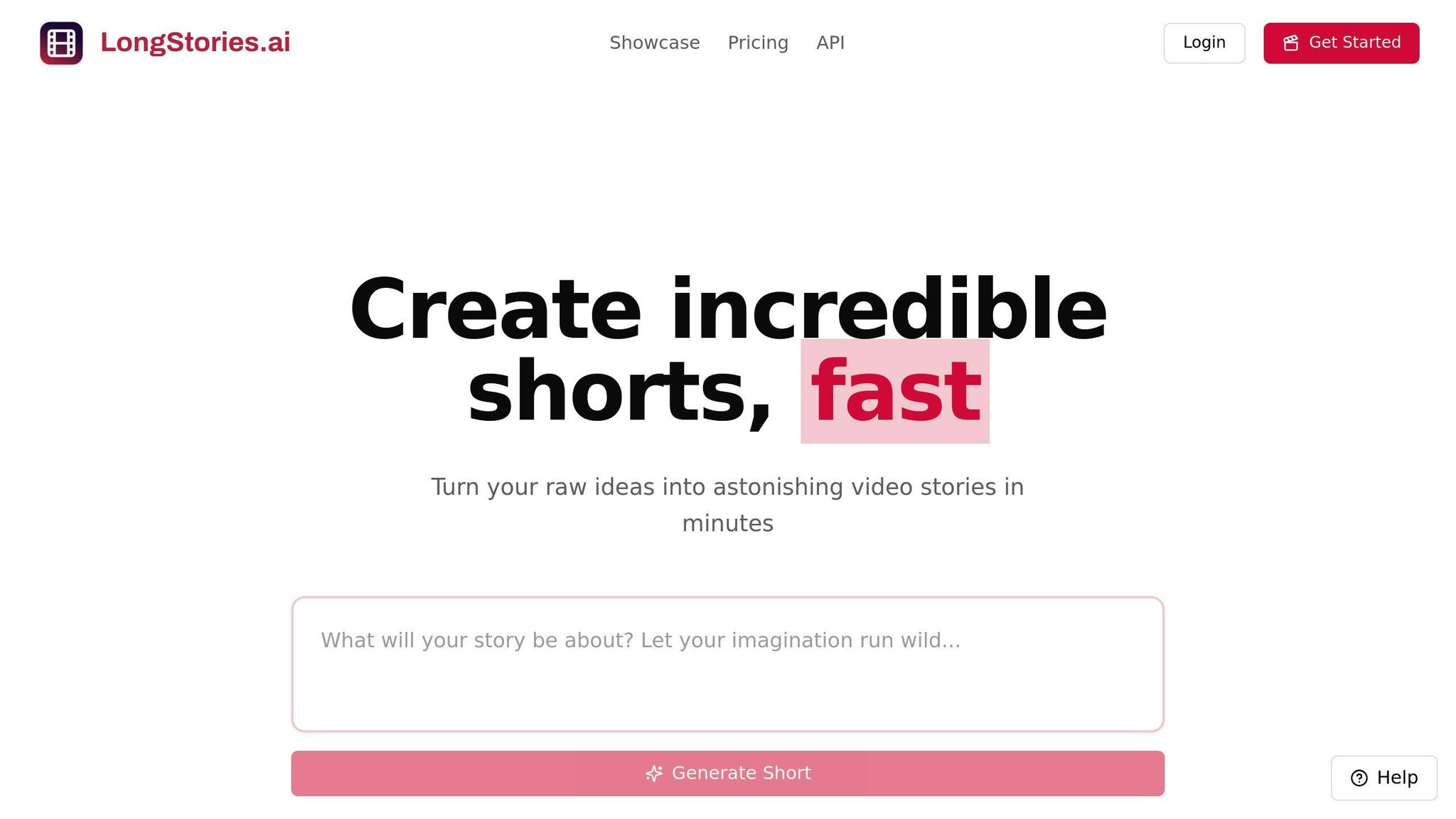
LongStories is constantly evolving as it finds its product-market fit. Features, pricing, and offerings are continuously being refined and updated. The information in this blog post reflects our understanding at the time of writing. Please always check LongStories.ai for the latest information about our products, features, and pricing, or contact us directly for the most current details.
How to Create Branching Scenarios in Videos
Branching scenarios in videos let viewers make decisions that shape the story, making them active participants instead of passive watchers. This approach is used in training, education, and marketing to engage audiences and improve learning or decision-making. Here's how to get started:
Key Steps:
- Set Objectives: Define learning goals, target behaviors, and success metrics.
- Storyboard: Plan decision points, paths, and transitions.
- Create Content: Develop realistic challenges with clear outcomes.
- Choose Tools: Use platforms like LongStories.ai, Hihaho, or Cinema8 to build and track interactive videos.
- Test & Refine: Ensure smooth functionality, gather feedback, and improve based on user engagement.
Benefits:
- Boosts engagement and retention.
- Simulates real-world decision-making.
- Customizes learning experiences.
Quick Comparison of Tools:
| Tool | Best For | Features | Price |
|---|---|---|---|
| LongStories.ai | Quick content creation | AI tools, templates, analytics | From $9/month |
| Hihaho | Education | Tracking, unlimited trials | Free trial available |
| Cinema8 | Enterprise training | Gamification, AI integration | $249–$1199/month |
| Kumullus | LMS integration | Simple interface | €149/month |
Start by defining your goals and using tools that simplify the process. Platforms like LongStories.ai make it easy to create engaging, interactive videos tailored to your audience.
How to Create Branching Scenarios (Instructional Design Tips)
Planning a Branching Video Scenario
Creating branching scenarios that work well takes thoughtful planning and a clear process. Here's how to design interactive video content that meets your goals.
Setting Objectives and Outcomes
Start by focusing on three main components:
| Component | Purpose | Example |
|---|---|---|
| Learning Goals | Define what skills or knowledge to teach | Decision-making in sales |
| Target Behaviors | Pinpoint the desired viewer actions | Following compliance protocols |
| Success Metrics | Set measurable outcomes to track success | Completion rates, engagement |
Once these objectives are nailed down, you can move on to designing the viewer's journey with a detailed storyboard.
Creating a Storyboard
Nicola Wylie puts it best:
"You wouldn't build a house without a blueprint, and the same applies to instructional design."
Your storyboard should include these key elements:
- Screen or slide numbers and titles
- Decision points and how they connect
- Visual details and transitions
- Navigation paths between scenarios
Even straightforward branching designs can get tricky. A clear storyboard keeps everything organized and sets the stage for building your content.
Developing Content and Decision Points
Using your storyboard as a foundation, the next step is to create the actual content and decision points. Make sure decision points:
- Offer realistic challenges with clear outcomes for each choice
- Provide helpful feedback based on the viewer's decisions
- Keep the audience engaged with a strong narrative
"The strength of a branched scenario lies in delivering outcomes tailored to the viewer's choices and path."
Plan the viewer's journey carefully before production. This ensures smooth scene transitions and keeps the storyline consistent across all branches.
Selecting Tools for Branching Scenarios
Picking the right tool for creating branching scenarios can make or break your interactive video project. With numerous options available, it's important to find one that matches your skill level and project needs.
What to Look for in a Tool
For effective branching scenarios, focus on tools that offer strong interactivity, easy-to-use interfaces, analytics, and integration options. Here's a breakdown of key features to consider:
| Feature Category | Description | Why It Matters |
|---|---|---|
| Interactivity Options | Branching paths, hotspots, decision points | Allows for more complex and dynamic scenarios |
| User Interface | Drag-and-drop functionality, visual editors | Speeds up the development process |
| Analytics | Tracks viewer behavior, completion rates | Helps measure the success of your scenarios |
| Integration | LMS compatibility, API access | Ensures smooth workflows with existing systems |
One tool that stands out in this space is LongStories.ai, which uses AI to streamline branching scenario creation.
LongStories.ai: Simplifying Scenario Creation with AI

LongStories.ai is designed to make branching scenarios easier to build. It combines AI-powered tools with customizable templates and API access, making it a great choice for interactive educational content. Key features include:
- Customizable templates tailored for various learning needs
- Advanced analytics to monitor learner engagement
- API access for automated video creation
- Team collaboration tools with dedicated support
Comparing Popular Tools
Here's a quick comparison of leading tools for branching scenarios:
| Tool | Best For | Notable Features | Price Range |
|---|---|---|---|
| Hihaho | Educational Content | Unlimited trials, detailed tracking | Free trial available |
| Cinema8 | Enterprise Training | AI integration, gamification | $249-$1199/month |
| Kumullus | LMS Integration | Easy-to-use interface | €149/month |
| LongStories.ai | Quick Content Creation | AI-powered generation, API access | Starting at $9/month |
"Interactive videos can significantly increase learner engagement and retention compared to traditional linear videos", notes a study by Wyzowl. In fact, viewers spend 47% more time watching interactive content than standard video formats.
sbb-itb-94859ad
Steps to Create a Branching Video
Building a branching video takes thoughtful planning and execution. Here's how to craft an engaging interactive experience.
Scripting for Branching Paths
Your storyboard and objectives guide the scripting process, ensuring every branch aligns with your goals. Focus on creating a clear narrative while keeping complexity manageable:
| Scripting Element | Best Practice | Purpose |
|---|---|---|
| Decision Points | 2-3 choices per branch with strategic bottlenecks | Avoids overwhelming viewers while allowing course corrections |
| Branch Length | 30-60 seconds between choices | Keeps viewers engaged |
| Total Paths | 8-12 alternate endings | Adds variety without overcomplicating |
Design branches to reflect relatable scenarios, like customer service interactions or workplace training, to make the content more practical and engaging.
Adding Interactive Features
Interactive elements make viewers active participants, allowing them to shape their own experience. Studies show that interactive video ads are 32% more memorable than static ones.
Here’s how to incorporate these features:
-
Clickable Choice Points
Use clear, visually distinct buttons that link to specific video segments. Ensure smooth transitions between branches for a seamless experience. -
Feedback Mechanisms
Add instant feedback through visuals or text, use animations for transitions, and include progress indicators to guide viewers. -
Progress Tracking
Utilize your platform’s tracking tools to monitor viewer choices and adjust content paths as needed.
Testing and Refining the Video
"Storyboarding is crucial for complex interactive videos. The simplest, cleanest experiences are the ones that gain the most interaction."
Before finalizing, test thoroughly:
- Check all branches for functionality, timing, and feedback across devices.
- Collect user feedback to pinpoint confusing areas.
- Analyze engagement trends, such as most/least chosen paths and average completion times.
Based on these insights, fine-tune the video by simplifying overly complex sections and clarifying decision points.
"Interactive videos take things to the next level, turning passive viewers into active learners." - WeVideo
Platforms like LongStories.ai can simplify this process, especially for educational or business-focused content. Their AI tools help ensure smooth transitions and consistent quality across all branches.
Guidelines for Effective Branching Scenarios
Building on the scripting and interactive features discussed earlier, these tips will help make your scenarios engaging and impactful.
Crafting Meaningful Choices
The 3 Cs framework - Challenge, Choices, and Consequences - is a proven way to create engaging decision points. It works by presenting clear problems, offering realistic options, and showing outcomes that feel authentic.
| Element | Purpose | Tips for Implementation |
|---|---|---|
| Challenge | Sets the context | Present clear, relevant problems that need solving. |
| Choices | Drives engagement | Offer 2-3 realistic options for each decision point. |
| Consequences | Reinforces learning | Show outcomes that reflect real-world situations. |
Tools like LongStories.ai can simplify the process of building branching paths and decision points, making it easier to integrate these principles.
Balancing Complexity and Experience
Interactive videos that balance complexity tend to have higher completion rates. To achieve this balance, use techniques like bottlenecks to streamline paths, focus on key decision points, and ensure smooth transitions with continuous audio and clear visuals. For optimal design, dedicate 50% of the screen to content and the other 50% to interactive elements.
Providing Decision Feedback
Feedback plays a key role in keeping viewers engaged and helping them learn. Instead of simply pointing out errors, show the consequences of their decisions in a way that feels natural and immersive.
- Immediate Response: Let viewers see the outcomes of their choices as the scenario unfolds.
- Contextual Learning: Blend feedback seamlessly into the storyline to keep the experience immersive.
- Progressive Disclosure: Allow the impact of decisions to reveal itself over time through the narrative, rather than providing instant corrections.
"When done well, scenarios guide learners deeper into problem-solving activities that can help change behavior and improve outcomes."
Research from Near-Life highlights that experiencing the results of decisions improves retention more effectively than basic right/wrong feedback.
Conclusion and Next Steps
Key Takeaways
Interactive videos can boost viewer engagement by as much as 30% compared to standard linear content. To make branching scenarios effective, it's important to set clear goals, create meaningful choices for viewers, and thoroughly test your content. The trick is balancing complexity while keeping the experience user-friendly and focused on your learning objectives.
How LongStories.ai Can Help
Platforms like LongStories.ai make it easier to create interactive videos. With user-friendly tools and features designed for educational and training content, it simplifies the process of building branching scenarios. The platform is particularly useful for generating short-form video content quickly, allowing you to experiment with multiple branches without spending too much time on production.
Getting Started with Your Project
To kick off your interactive video project, start by defining clear objectives that match your audience's needs. Build a main storyline with meaningful branches, and choose tools that simplify the development and testing process. Focus on quality over quantity - engagement comes from concise, well-thought-out video segments.
"Interactive video-based branching courses represent the future of eLearning, offering a dynamic, personalized, and engaging learning experience."
For a strong start, try LongStories.ai's Aspiring Storyteller plan. It gives you 500 monthly credits and full access to all features, making it ideal for testing your first branching scenarios without watermarks or outros.
FAQs
What is branching in learning?
Branching in learning is an interactive method where the learner's choices determine their path, making the experience more tailored. For example, in a customer service training video, participants might decide between offering a refund, asking follow-up questions, or escalating the issue to a supervisor. Each decision leads to a unique outcome, showing the consequences of their actions.
How do branching scenarios boost engagement?
When learners see their decisions directly influence outcomes, they become more invested. With careful planning and the right tools, branching scenarios create an engaging experience by mimicking real-world situations and improving retention.
What tools are available?
Several tools can help you create branching scenarios:
| Tool | Best For |
|---|---|
| LongStories.ai | Quick, AI-driven content |
| Cinema8 | Detailed, complex scenarios |
| Twine | Text-based branching |
| Storyline | Corporate training needs |
How can I measure success?
Track success by analyzing:
- Completion rates for various branches
- Time spent on decision-making points
- Patterns in choices made by learners
- How well outcomes align with learning goals
These metrics will help you refine your scenarios and ensure they effectively engage and educate your audience.
